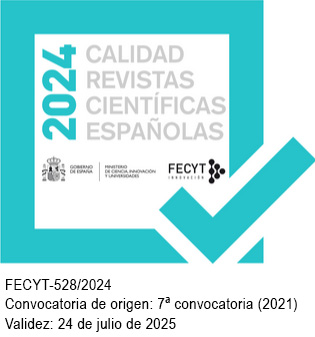The Expression of Explicitness in Sexist Messages in Social Networks: A Quantitative Analysis of X Practices
doi: https://doi.org/10.31810/rsel.55.1.6
Keywords:
Sexism; social media; corpus; explicitness; XAbstract
This paper explores the expression of explicitness in sexist messages disseminated through social networks, focusing on X. Based on the EXIST 2021 corpus (Rodríguez-Sánchez et al., 2021), a representative sample is reanalyzed and the hypothesis that explicitness constitutes a distinctive feature of sexist messages in social networks is proposed. To address this question, 634 messages are analyzed in three different phases of work: verification, in which it is identified whether or not the message is sexist; classification of the type of sexism contained in the text; and evaluation of its explicitness degree. The outcome obtained in the present research indicates that sexist messages tend to be more explicit than those messages that denounce sexism. This finding is supported by analytical tests, revealing a statistically significant difference between messages labelled as sexist and those categorised as denouncing sexism, which show a lower degree of explicitness. In conclusion, the present work provides empirical evidence that reinforces the relationship between sexist content and the expression of explicitness in digital discourse.
Downloads
References
Adams, F., Aizawa, K. y Fuller, G. (1992), Rules in Programming Languages and Networks. Dinsmore, pp. 49–68.
Ahmed, S. (2015). Introduction: Sexism-A problem with a name. New formations: a journal of culture/theory/politics, 86(1), pp. 5-13.
Akinnaso, F. N. (1982). On the differences between spoken and written language. Language and speech, 25(2), pp. 97-125. doi: https://doi.org/10.1177/00238309820250020
Baker, M. (1996). Corpus-Based Translation Studies. The Challenges that Lie ahead. En: Somers, H. (ed.) Terminology, LSP and Translation: Studies in Language Engineering in Honour of Juan C. Sager. Amsterdam, Philadelphia: John Benjamins, pp. 233–250.
Basile, V., Bosco, C., Fersini, E., Nozza, D., Patti, V., Pardo, F., Rosso, P. y Sanguinetti, M. (2019). SemEval-2019 Task 5: Multilingual Detection of Hate Speech Against Immigrants and Women in Twitter. Proceedings of the 13th International Workshop on Semantic Evaluation, pp. 54-63. doi: https://doi.org/10.18653/v1/S19-2007
Baumgarten, N., Meyer, B. y Özçetin, D. (2008). Explicitness in translation and interpreting: A critical review and some empirical evidence (of an elusive concept). Across Languages and Cultures, 9(2), pp. 177-203. doi: https://doi.org/10.1556/Acr.9.2008.2.2
Becker, J. C. y Sibley, C. G. (2015). Sexism. En Handbook of prejudice, stereotyping, and discrimination. Psychology Press, pp. 315-336.
Bedmar Gómez, M. J. (1989). La norma del texto oral y la norma del texto escrito. Revista española de lingüística, 19(1), pp. 111-120.
Berg, S. H. (2006). Everyday Sexism and Posttraumatic Stress Disorder in Women: A Correlational Study. Violence Against Women, 12(10), pp. 970-988. doi: https://doi.org/10.1177/1077801206293082
Blanco Rodríguez, M. J. (2002). El chat: la conversación escrita. ELUA. Estudios de Lingüística, 16, pp. 43-87.
Blum-Kulka, S. (1986). Shifts of Cohesion and Coherence in Translation. En House, J. y Blum-Kulka, S. (eds.) Interlingual and intercultural communication: Discourse and cognition in translation and second language acquisition studies, 272, p. 17.
Bram, J. T., Jia, L., Huffman, W. y Ahn, J. (2021). Orthopaedic surgery residency program social media presence during the COVID-19 pandemic. JBJS Open Access, 6(4), e21. doi: https://doi.org/ 2106/JBJS.OA.21.00073
Briz Gómez, A. (1998). El español coloquial en la conversación: esbozo de pragmagramática. Barcelona, Ariel.
Bustos Tovar, J. J. D. (1997). Organización textual y oralidad. Quaderns de filología. Estudis lingüístics, 2, pp. 7-24.
Calsamiglia Blancafort, H. y Tusón Valls, A. (1999). Las cosas del decir. Barcelona, Ariel.
Carston, R. (2008). Thoughts and utterances: The pragmatics of explicit communication. John Wiley & Sons.
Chafe, W. y Tannen, D. (1987). The relation between written and spoken language. Annual review of anthropology, 16, pp. 383-407.
Chew, Pat K. y Kelley-Chew, Lauren K. (2008). Subtly Sexist Language. 16(3), pp. 643-678.
Chung, A. Q., Andreev, P., Benyoucef, M., Duane, A. y O’Reilly, P. (2017). Managing an organisation’s social media presence: An empirical stages of growth model. International Journal of Information Management, 37(1), pp. 1405-1417. doi: https://doi.org/10.1016/j.ijinfomgt.2016.10.003
Clark, A. (1993) Associative Engines, Cambridge, MA, MIT Press.
Collot, M. y Belmore, N. (1996). Electronic language. Computer-Mediated Communication: Linguistic, Social and Cross-Cultural Perspectives. Amsterdam/Philadelphia: John Benjamins Publishing Company, pp, 13-28.
Connell, R. (2005). Masculinities. Routledge. doi: https://doi.org/10.4324/9781003116479
Crystal, D. (2001). Language and the Internet. Cambridge University Press. doi: https://doi.org/10.1017/CBO9781139164771
Crystal, D. (2011). Internet linguistics: A student guide. Routledge.
Cummins, R. (1989). Mental representation, Cambridge, MA, MIT Press.
Dembe, T. (2024). The impact of social media on language evolution. European Journal of Linguistics, 3(3), 1-14.
Doherty, M. (2002). Language processing in discourse: A key to felicitous translation. Routledge. doi: https://doi.org/10.4324/9780203216934
McClelland, J. L. y Elman, J. L. (1986). The TRACE model of speech perception. Cognitive Psychology, 18(1), pp. 1-86. doi: https://doi.org/10.1016/0010-0285(86)90015-0
Expósito, F.; Moya, M. C. y Glick, P. (1998). Sexismo ambivalente: medición y correlatos. Revista de Psicología Social, 13(2), pp. 159-169. doi: https://doi.org/10.1174/021347498760350641
Fabricius-Hansen, C. (1996). Informational density: a problem for translation and translation theory. Linguistics, 34, pp.521-565. doi: https://doi.org/10.1515/ling.1996.34.3.521
Fabricius-Hansen, C. (1999). Information packaging and translation: Aspects of translational sentence splitting (German–English/Norwegian). Sprachspezifische Aspekte der Informationsverteilung, pp. 175-214. doi: https://doi.org/10.1515/9783050078137-008
Fersini, E.; Rosso, P. y Anzovino, M. (2018). Overview of the task on automatic misogyny identification at IberEval 2018. 2150, pp. 214-228.
Fodor, J. y Pylyshyn, Z. W. (1988). Connectionism and cognitive architecture: A critical analysis, Cognition, 28, pp. 3–71. doi: https://doi.org/10.1016/0010-0277(88)90031-5
Forster, K. I. (1976). Accessing the mental lexicon. En R. J. Wales y E.W. Walker (eds.), New approaches to language mechanisms. Amsterdam: North Holland.
Forster, K. I. (1979). Levels of processing and the structure of the language processor. Sentence processing, pp. 27-85.
Forster, K. I. (1989). Basic issues in lexical processing. In W. Marslen-Wilson (Ed.), Lexical representation and process. The MIT Press, pp. 75–107.
Fox, J.; Cruz, C. y Lee, J. Y. (2015). Perpetuating online sexism offline: Anonymity, interactivity, and the effects of sexist hashtags on social media. Computers in human behavior, 52, pp. 436-442. doi: https://doi.org/10.1016/j.chb.2015.06.024
Frenda, S., Ghanem, B., Montes-y-Gómez, M. y Rosso, P. (2019). Online hate speech against women: Automatic identification of misogyny and sexism on Twitter. Journal of Intelligent & Fuzzy Systems, 36(5), pp. 4743-4752. doi: https://doi.org/10.3233/JIFS-179023
Gumul, E. (2006). Explicitation in simultaneous interpreting: A strategy or a by-product of language mediation?. Across languages and cultures, 7(2), pp. 171-190. doi: https://doi.org/10.1556/Acr.7.2006.2.2
Hadley, R.F. (1995). The explicit-implicit distinction. Minds and machines, 5, pp. 219–242. doi: https://doi.org/10.1007/BF00974745
Hall, A. y Mazzarella, D. (2023). Pragmatic inference, levels of meaning and speaker accountability. Journal of pragmatics, 205, pp. 92-110. doi: https://doi.org/10.1016/j.pragma.2022.12.007
Halliday, M. A. (1987). Spoken and written modes of meaning. In Comprehending oral and written language. Brill, pp. 55-82. doi: https://doi.org/10.1163/9789004653436_006
Harweg, R. (1986). Language is not just speech: A functional approach to different modes of linguistic representation. Semiotica, 61, pp. 285-306. doi: https://doi.org/10.1515/semi.1986.61.3-4.285
Harweg, R. (1987). Remarks on the topology and kinematics of speech and writing. Semiotica, 63, pp. 253-267. doi: https://doi.org/10.1515/semi.1987.63.3-4.253
Herring, S. C. (2013). Discourse in Web 2.0: Familiar, reconfigured, and emergent. Discourse, 2(0), pp. 1-26.
Herring, S., y Dainas, A. (2017). «Nice picture comment!» Graphicons in Facebook comment threads. Hawaii International Conference on System Sciences. doi: https://doi.org/10.24251/HICSS.2017.264
Honey, C. y Herring, S. C. (2009). Beyond microblogging: Conversation and collaboration via Twitter. En 2009 42nd Hawaii International Conference on System Sciences, pp. 1-10. doi: https://doi.org 10.1109/HICSS.2009.89
House, J. (1996). Contrastive discourse analysis and misunderstanding: The case of German and English. Contributions to the Sociology of Language, 71, pp. 345-362. doi: https://doi.org/10.1515/9783110811551.345
House, J. (1997). Translation quality assessment. A model revisited. Tübingen: Narr.
House, J. (2003). Misunderstanding in intercultural university encounters. En Misunderstanding in social life. Routledge, pp. 22-56.
Jiménez Gómez, J. y Vela Delfa, C. (2005). La escritura electrónica: ¿progreso o decadencia? Interlingüística, 16, pp. 621-630.
Johnson, M. (2024). Relevance theory and the social realities of communication. Frontiers in Psychology, 14, 1167790. doi: https://doi.org/10.3389/fpsyg.2023.1167790
Johnstone, B. (2008). Discourse analysis. Blackwell Publishing.
Kirsh, D. (1990). When is information explicitly represented?, en P. Hanson (ed.), Information, Language and Cognition: Vancouver Studies in Cognitive Science Vancouver: University of British Columbia Press, pp. 340–365.
López Alonso, C. (2014). Análisis del Discurso. Síntesis.
Malik, B., Iftikhar, F. y Gurmani, T. (2025). Transformative impact of social media platforms on language evolution: Creation and adoption of emerging lexicon. Journal of Arts and Linguistics Studies, 3(1), 243-267. doi: https://doi.org/10.71281/jals.v3i1.218
Mancera Rueda, A. (2014). El sexismo como blanco del humor en las redes sociales. Feminismo/s, 24, pp. 163-192. doi: http://dx.doi.org/10.14198/fem.2014.24.08
Marslen-Wilson, W. (1987). Functional parallelism in spoken word recognition. Cognition, 25(1-2), pp. 71-102. doi: https://doi.org/10.1016/0010-0277(87)90005-9
Marslen-Wilson, W. (1990). Activation, competition, and frequency in lexical access. Cognitive models of speech processing: Psycholinguistic and computational perspectives, Gerry T. M. Altmann. doi: https://doi.org/10.7551/mitpress/1889.003.0008
Martínez, F. y Ezquerro, J. (1998). Explicitness with psychological ground. Minds and Machines, 8(3), pp. 353-374. doi: https://doi.org/10.1023/A:1008275132559
Marwick, A. E. y Boyd, D. (2011). I tweet honestly, I tweet passionately: Twitter users, context collapse, and the imagined audience. New Media & Society, 13(1), pp. 114-133. doi: https://doi.org/10.1177/1461444810365313
Melero Carnero, L. (2023). Análisis de las estrategias discursivas cibersexistas en twitter. En Ensayos ciberfeministas. Dykinson, pp. 154-170.
Melero Carnero, L. (2024). Estrategias de descortesía verbal sexista hacia Irene Montero en los comentarios de Twitter (X). Feminismo/s, 44, pp. 453-484.
Mondal, M., Araújo Silva, L., Correa, D. y Benevenuto, F. (2018). Characterizing usage of explicit hate expressions in social media. New review of hypermedia and multimedia, 24(2), pp. 110-130. doi: https://doi.org/10.1080/13614568.2018.1489001
Morency, P., Oswald, S. y Saussure, L. de (2008). Explicitness, implicitness and commitment attribution: A cognitive pragmatic approach. Belgian journal of linguistics, 22(1), pp. 197-219. doi: https://doi.org/10.1075/bjl.22.10mor
Morton, J. (1964). A preliminary functional model for language behaviour. International Audiology, 3(2), pp. 216-225. doi: https://doi.org/10.3109/05384916409074089
Morton, J. (1970). A functional model for memory. Models of human memory, pp. 203-254.
Murtisari, E. T. (2016). Explicitation in translation studies: The journey of an elusive concept. Translation & interpreting: The International Journal of Translation and Interpreting Research, 8(2), pp. 64-81. doi: https ://doi.org/10.12807/ti.108202.2016.a05
Nani, N. (2024). The influence of language on lnteraction and communication within social media platforms. Focus Journal Language Review, 2(2). doi: https://doi.org/10.62795/fjlg.v2i2.295
Nguyen, D., Gravel, R. Trieschnigg, D. y Meder, T. (2013). «How old do you think I am?» A study of language and age in Twitter. In Proceedings of the International AAAI Conference on Web and Social Media. 7(1), pp. 439-448. doi: https://doi.org/10.1609/icwsm.v7i1.14381
Page, R., Barton, D., Lee, C., Unger, J. W. y Zappavigna, M. (2022). Researching language and social media: A student guide. Routledge. doi: https://doi.org/10.4324/9781003121763
Pápai, V. (2004). Explicitation: A universal of translation text? En A. Mauranen y P. Kujamäki (eds.), Translation universals: Do they exist? John Benjamins Publishing Co. pp.143-164.
Pérez Juliá, M. (1997). Tres parámetros para una caracterización del concepto de escritura. Quaderns de Filologia. Estudis Lingüístics, 2, pp. 25-38.
Piñeiro-Otero, T. y Martínez-Rolán, X. (2021). Eso no me lo dices en la calle. Análisis del discurso del odio contra las mujeres en Twitter. El Profesional de la información. 30(5). doi: https://doi.org/10.3145/epi.2021.sep.02
Plunkett, K. (1993), Making nets work hard. Mind and Language, 8, pp. 549–558. doi: https://doi.org/10.1111/j.1468-0017.1993.tb00303.x
O’Brien G. J. y Opie, J. (1997) Cognitive science and phenomenal consciousness: A dilemma, and how to avoid it. Philosophical Psychology, 10, pp. 269-286. doi: https://doi.org/10.1080/09515089708573220
Ochs, E. (1979). Planned and unplanned discourse. en Givón, Thomas, ed., Syntax and Semantics, vol. 12: Discourse and Syntax. Academic Press, pp. 51-80.
Olohan, M. y Baker, M. (2000). Reporting that in translated English. Evidence for subconscious processes of explicitation?. Across languages and cultures, 1(2), pp. 141-158. doi: https://doi.org/10.1556/Acr.1.2000.2.1
Redeker, G. (1984). On differences between spoken and written language. Discourse processes, 7(1), pp. 43-55. doi: https://doi.org/10.1080/01638538409544580
Rodríguez-Sánchez, F., Carrillo-de-Albornoz, J., Plaza, L., Gonzalo, J., Rosso, P., Comet, M. y Donoso, T. (2021). Overview of exist 2021: sexism identification in social networks. Procesamiento del Lenguaje Natural, 67, pp. 195-207.
Rodríguez-Sánchez, F., Carrillo-de-Albornoz, J., Plaza, L., Mendieta-Aragón, A., Marco-Remón, G., Makeienko, M. y Rosso, P. (2022). Overview of exist 2022: sexism identification in social networks. Procesamiento del Lenguaje Natural, 69, pp. 229-240.
Rodríguez-Sánchez, F., Carrillo-de-Albornoz, J. y Plaza, L. (2024). Detecting sexism in social media: an empirical analysis of linguistic patterns and strategies. Applied Intelligence, pp.1-25. doi: https://doi.org/10.1007/s10489-024-05795-2
Sbisà, M. (2021). Presupposition and implicature: Varieties of implicit meaning in explicitation practices. Journal of Pragmatics, 182, pp. 176-188. doi: https://doi.org/10.1016/j.pragma.2021.05.027
Schmeisser-Nieto, W., Nofre, M. y Taulé, M. (2022). Criteria for the annotation of implicit stereotypes. In Proceedings of the Thirteenth Language Resources and Evaluation Conference (pp. 753-762). doi: https://aclanthology.org/2022.lrec-1.80/
Slovska, I. (2022). What is sexism? Analіtično-porіvnâlʹne pravoznavstvo, 2. doi: https://doi.org/10.24144/2788-6018.2022.02.17
Sperber, D. y Wilson, D. (1986). Relevance: communication and cognition. Blackwell.
Steiner, E. (2004). Translated texts: properties, variants, evaluations. Peter Lang.
Sylwester, K. y Purver, M. (2015). Twitter language use reflects psychological differences between democrats and republicans. PloS one, 10(9), e0137422. doi: https://doi.org/10.1371/journal.pone.0137422
Weerkamp, W., Carter, S. y Tsagkias, M. (2011). How people use Twitter in different languages. Text - Interdisciplinary Journal for the Study of Discourse.
Weissbrod, R. (1992). Explicitation in translations of prose-fictions from English to Hebrew as a function of norms. Multilingua, 11(2), pp. 153-171. doi: https://doi.org/10.1515/mult.1992.11.2.153
Wilson, D. y Sperber, D. (2012). Meaning and relevance. Cambridge University Press.
Yabuuchi, A. (1998). Spoken and written discourse: What’s the true difference? Semiotica, 120, pp. 1-37. doi: http://dx.doi.org/10.1515/semi.1998.120.1-2.1
Yates, S. J. (1996). Oral and written linguistic aspects of computer conferencing. En Herring, S. (ed). Computer-mediated communication: Linguistic, social and cross-cultural perspectives. John Benjamins, pp. 29-46. doi: http://dx.doi.org/10.1075/pbns.39.05yat
Yus, F. (1999). Misunderstandings and explicit/implicit communication. Pragmatics, 9(4), pp. 487-517. doi: https://doi.org/10.1075/prag.9.4.01yus
Yus, F. (2001). Ciberpragmática. Ariel.
Yus, F. (2010). Ciberpragmática 2.0. Ariel.
Zappavigna, M. (2011). Ambient affiliation: A linguistic perspective on Twitter. New media & society, 13(5), pp 788-806. doi: https://doi.org/10.1177/1461444810385097
Zappavigna, M. (2012). Discourse of Twitter and social media. Continuum.
Zhang, Y. y Dainas, A. R. (2024). Dialogues about graphicons in digital communication: Introduction to the special issue. Language@ Internet, 22, pp 1-8. doi: https://doi.org/10.14434/li.v22.40790
Published
How to Cite
Issue
Section
Copyright (c) 2025 Revista Española de Lingüística

This work is licensed under a Creative Commons Attribution-NonCommercial-NoDerivatives 4.0 International License.










